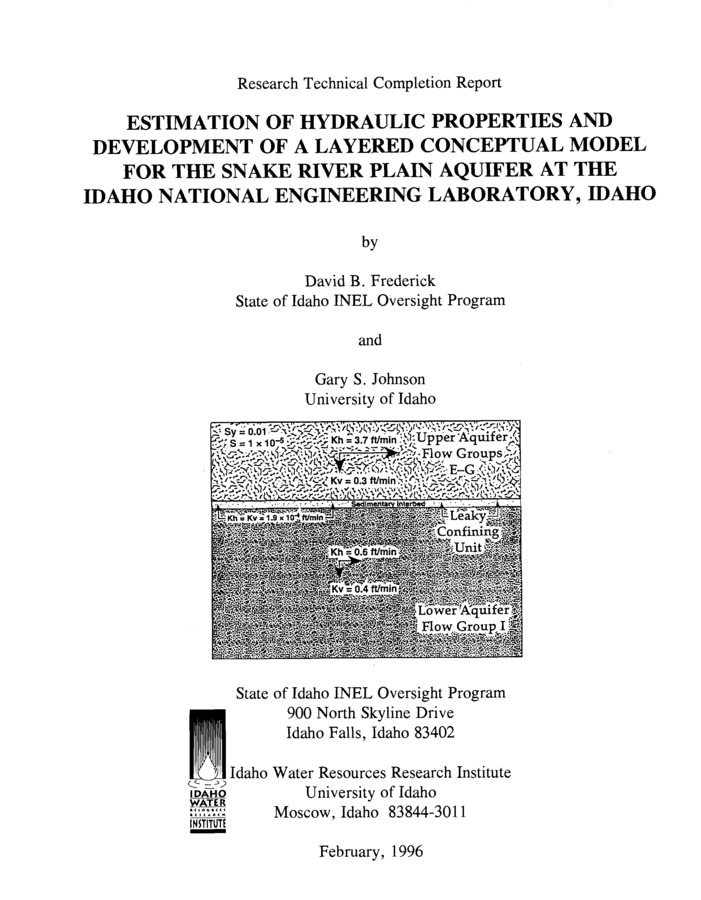PDF
Estimation of hydraulic properties and development of a layered conceptual model for the Snake River Plain aquifer at the Idaho National Engineering Laboratory, Idaho. Research Technical Completion Report Item Info
- Title:
- Estimation of hydraulic properties and development of a layered conceptual model for the Snake River Plain aquifer at the Idaho National Engineering Laboratory, Idaho. Research Technical Completion Report
- Authors:
- Frederick, David B.; Johnson, Gary S.
- Contributors:
- Idaho Water Resources Research Institute; IWRRI; Idaho National Engineering Laboratory; State of Idaho INEL Oversight Program
- Date:
- 1996-01
- Description:
- The Idaho INEL Oversight Program, in association with the University of Idaho, Idaho Geological Survey, Boise State University, and Idaho State University, developed a research program to determine the hydraulic properties of the Snake River Plain aquifer and characterize the vertical distribution of contaminants. A straddle-packer was deployed in four observation wells near the Idaho Chemical Processing Plant at the Idaho National Engineering Laboratory. Pressure transducers mounted in the straddle-packer assembly were used to monitor the response of the Snake River Plain aquifer to pumping at the ICPP production wells, located 2600 to 4200 feet from the observation wells. The time-drawdown data from these tests were used to evaluate various conceptual models of the aquifer. Aquifer properties were estimated by matching time-drawdown data to type curves for partially penetrating wells in an unconfined aquifer. This approach assumes a homogeneous and isotropic aquifer. The hydraulic properties of the aquifer obtained from the type curve analyses were: Storativity = 3 x 10"; Specific Yield = 0.01; Transmissivity = 740 ft2/min; Anisotropy (Kv:Kh)= 1: 360 Further evaluation of the time-drawdown data collected at various depth intervals in the aquifer indicated that drawdown generally increased with depth. Time-drawdown data were compared to the stratigraphy of the basalt flows and sedimentary interbeds at the Idaho National Engineering Laboratory developed by Anderson (1991). The greatest drawdown was observed in tested intervals below the top of Flow Group I. To evaluate the implications of this observation, a radial flow model was used to simulate three conceptual models for the Snake River Plain aquifer near the Idaho Chemical Processing Plant: 1) One Layer System: Single aquifer - Flow Groups E-I (homogeneous and anisotropic) 2) Two Layer System: Upper aquifer - Flow Groups E-G (homogeneous and anisotropic) Lower aquifer - Flow Group I (homogeneous and anisotropic) 3) Three Layer System: Upper aquifer - Flow Groups E-G (homogeneous and anisotropic) Confining unit - sedimentary interbed at the top of Flow Group I (homogeneous and isotropic) Lower aquifer - Flow Group I (homogeneous and anisotropic). The three-layer system, in which the upper 70 feet of the aquifer is unconfined, the sedimentary interbed at the top of Flow Group I is a leaky confining layer, and the basalt units in Flow Group I represent a leaky confined aquifer, provided the best match of simulated drawdown to observed drawdown. Estimates of the hydraulic properties of each layer were determined by trial and error model calibration. This optimization resulted in the following average estimates for the hydraulic properties of the composite, three-layer system: Storativity = 7 x 10"; Specific Yield = 0.009; Transmissivity = 430 ft2/min; Anisotropy (Kv:Kh)= 1:230 The estimated hydraulic properties for each of the three layers are as follows: 1) Upper aquifer (unconfined)--Horizontal conductivity = 3.7 ft/min; Vertical conductivity = 0.3 ft/min 2) Confining layer (leaky)--Horizontal conductivity = 1.4 x ft/min; Vertical conductivity = 1.4 x lo4 ft/min 3) Lower aquifer (leaky, confined)--Horizontal conductivity = 0.6 ft/min; Vertical conductivity = 0.4 ft/min Calibration of the radial flow model and type curve analysis resulted in similar estimates of the hydraulic properties of the aquifer system, despite major differences in the conceptual models (i.e. one layer versus three layers). For aquifer characterization studies with less quantitative objectives, such as an evaluation of an area's water supply potential, type-curve analysis may be adequate. However, for more complex needs, such as contaminant-transport modeling, it may be necessary to refine the conceptual model and corresponding estimates of the hydraulic properties.
- Subjects:
- hydraulic properties hydraulic models snake river aquifer characteristics groundwater flow wells models
- Location:
- Snake River Plain; Idaho National Engineering Laboratory
- Idaho County:
- Bonneville County
- Collection:
- IWRRI
- Series:
- IWRRI Technical Completion Report
- Source:
- Idaho Water Resources Research Institute, University of Idaho
- Identifier:
- IWRRI Number 199607
- Publisher:
- Idaho Water Resources Research Institute, University of Idaho
- Contributing Institution:
- University of Idaho
- Type:
- Text
- Format:
- application/pdf
- Cataloger:
- jh
- Date Digitized:
- 2015-06-02
- Language:
- eng
Source
- Preferred Citation:
- "Estimation of hydraulic properties and development of a layered conceptual model for the Snake River Plain aquifer at the Idaho National Engineering Laboratory, Idaho. Research Technical Completion Report", Idaho Waters Digital Library, University of Idaho Library Digital Collections, https://www.lib.uidaho.edu/digital/iwdl/items/iwdl-199607.html
Rights
- Rights:
- In copyright, educational use permitted. Educational use includes non-commercial reproduction of text and images in materials for teaching and research purposes. For other contexts beyond fair use, including digital reproduction, please contact the University of Idaho Library Special Collections and Archives Department at libspec@uidaho.edu. The University of Idaho Library is not liable for any violations of the law by users.
- Standardized Rights:
- http://rightsstatements.org/vocab/InC-EDU/1.0/

